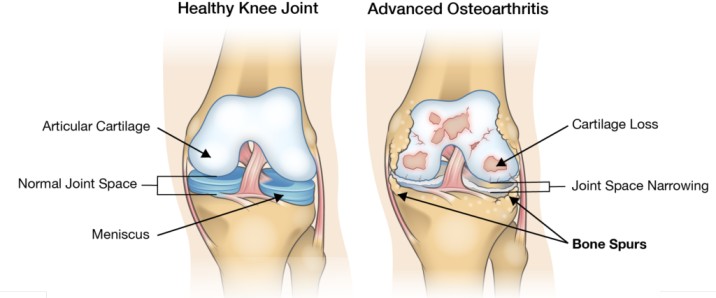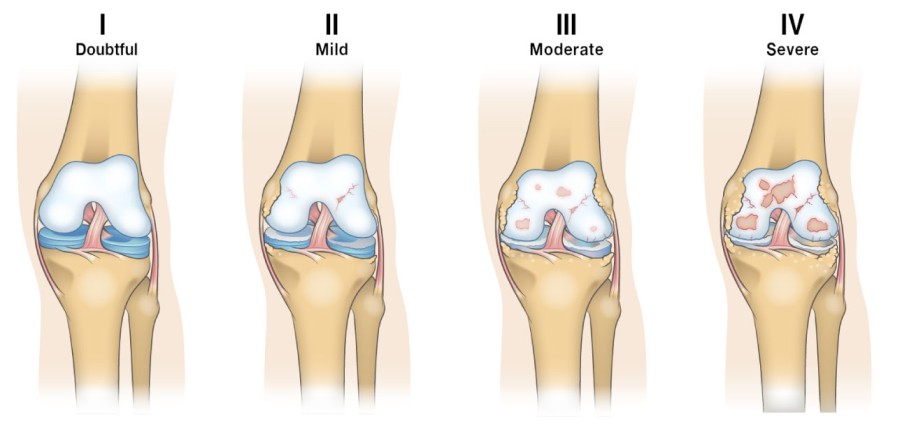Table of Contents
ToggleOsteoarthritis
Osteoarthritis is a type of arthritis that occurs when flexible tissue at the ends of bones wears down.
Osteoarthritis is a degenerative joint disease or sometimes called osteoarthrosis even though inflammation may be present.
It is the most common among the joint disorders and also the most disabling.

Types of Osteoarthritis
- Primary Osteoarthritis
it’s the most common and it affects the spine, fingers, hips, knees and great big toes and it has no obvious cause
- Secondary Osteoarthritis
occurs with a pre existing abnormality e.g injury or trauma. This can be due to septic arthritis and congenital abnormalities.
Kellgren-Lawrence Classification of Osteoarthritis

- grade 0 (none): definite absence of x-ray changes of osteoarthritis
- grade 1 (doubtful): doubtful joint space narrowing and possible osteophytic lipping
- grade 2 (mild/minimal): definite osteophytes and possible joint space narrowing
- grade 3 (moderate): moderate multiple osteophytes, definite narrowing of joint space and some sclerosis and possible deformity of bone ends
- grade 4 (severe): large osteophytes, marked narrowing of joint space, severe sclerosis and definite deformity of bone ends
Osteoarthritis is deemed present at grade 2 although of minimal severity

Pathophysiology of Osteoarthritis
- Osteoarthritis occurs when the cartilage that cushions the ends of the bone in the joints gradually decreases.
- Cartilage is a firm slippery tissue that permits nearly frictionless joint motion. In osteoarthritis, the slick surface of the cartilage becomes rough eventually and if the cartilage wears down completely, bones will be left rubbing onto another bone.
- Mechanical injury. OA starts from an injury of the articular cartilage, subchondral bone, and synovium.
- Chondrocyte response. Factors that initiate chondrocyte response include previous joint damage, genetic and hormonal factors, and others.
- Cytokines. After the chondrocyte response, the release of cytokines occurs.
- Stimulation of enzymes. Proteolytic enzymes, metalloproteases, and collagenase are stimulated, produced, and, released.
- Damage. The resulting damage predisposes to damage further as the chondrocyte is triggered to respond again.
Cause
- Increased age. Most elderly people experience osteoarthritis because the ability of the articular cartilage to resist microfracture with repetitive loads diminishes with age.
- Obesity. Obese people easily wear out their weight-bearing joints because of their increased weight.
- Previous joint damage. Having previous joint damage predisposes the patient to secondary OA.
- Repetitive use. Repetitive use due to occupational or recreational factors also causes OA.
Predisposing Factors
- Age. the risk increases with age
- Diabetes or other rheumatic diseases
- Genetics
- Hormonal imbalance
- Bone deformities
- Increased cholesterol levels
- Obesity
- Sex more common in females than males
- Joint injuries
Signs and Symptoms
- Limited movements of the joints
- Pain and tenderness
- Swelling
- Stiffness lasting for a short time after a period of inactivity or when waking up
- Crackling noise
- Enlarged distorted joints
- Bone spurs- these are extra bits of bone which feel like hard lumps may form around the affected joint.
Investigations and Diagnosis
- Physical assessment. Physical assessment of the musculoskeletal system reveals the tender and swollen joints.
- X-ray. Osteoarthritis characterized by a progressive loss of joint cartilage, which appears on x-ray as a narrowing of the joint space.
- Routine blood tests can be useful to exclude infective causes and inflammatory causes.
- MRI use of radio waves and strong magnetic fields to produce detailed images of bone and soft tissues including cartilages.
- Joint fluid analysis : Use of a needle to draw fluid out of the affected joints. This helps to determine if there is inflammation or if pain is caused by gout or an infection.
Management of Osteoarthritis
Aims
- To relief pain
- To minimize progress of the condition
- To restore normal functions of the bones.
Management according to classification/ severity.
- Grade 1- doubtful: patients will develop very minor wear and tear and bone spur growth at the end of the knee joints. Pain and discomfort are rarely felt.
Treatment
- If the patient is not predisposed to O.A, orthopedic physicians may not recommend any special treatment
- Supplement such as glucosamine may be recommended.
- Exercises are also recommended
Grade 2-mild
- A diagnostic images or x-rays of the knee joint will show more bone spur growth and through the space between the bones appear normal, people will begin experiencing symptoms of the joint pain. The area around the knee joint will feel stiff and uncomfortable mainly when sitting for a long time or in the morning after waking up after a period of inactivity.
Treatment
- non pharmacological therapies to relieve pain and discomfort
- exercise and strength training for increased joint stability.
- Helping devices
Grade 3- moderate
- obvious erosion to the cartilage surface between bones and fibrillation narrow the gap between the bone
- Crepitus sounds
Treatment
- Over counter NSAIDS or pain relief therapies.
- If not effective, doctor may prescribe codeine and oxycodeine.
Supportive treatment
- Physical therapy if it does not work, patient is given articular cortisone.
- Hyaluronic acid over 3-5 weeks time.
Grade 4- Severe
The joint space is reduced causing cartilage to wear off, leaving the joint stiff which leads to a chronic inflammatory response, with decreased synovial fluid that causes friction, greater pain and discomfort when walking or moving the joint.
There is increased production of synovial metalloproteinases, cytokines and TNF(Tumour necrosis factor ) that can diffuse back into the cartilage to destroy soft tissue around the knee.
Treatment.
- Incase of severe O.A of the knee, an option is performing osteotomy or bone realignment surgery where the orthopedic surgeon cuts the bone above or below the knee to shorten the length and help realign it for less stress on the joint.
- Another surgical option is total knee replacement or arthroplasty.
- Arthroplasty. Diseased joint components are replaced in arthroplasty.
Prevention
- Weight reduction. To avoid too much weight upon the joints, reduction of weight is recommended.
- Prevention of injuries. As one of the risk factors for osteoarthritis is previous joint damage, it is best to avoid any injury that might befall the weight-bearing joints.
- Perinatal screening for congenital hip disease. Congenital and developmental disorders of the hip are well known for predisposing a person to OA of the hip.
- Keeping a healthy body weight
- Reduce on sugar intake.
Complications
- Bone death
- Bleeding inside the joint
- Rapid complete break down of cartilage
- Infection of the joint
- Rupture of tendons and


Some questions
good notes